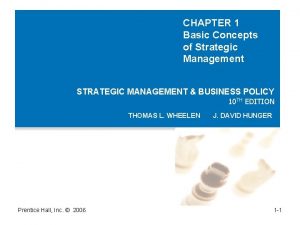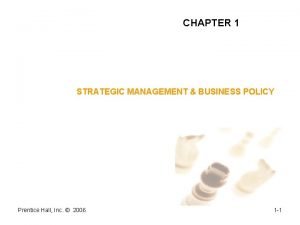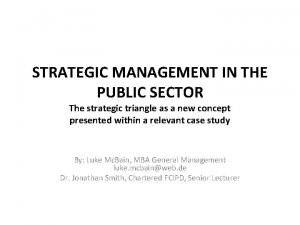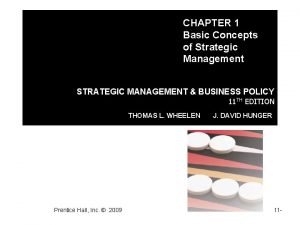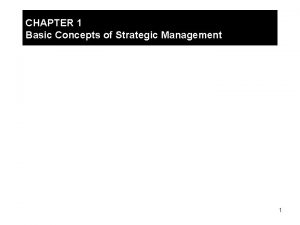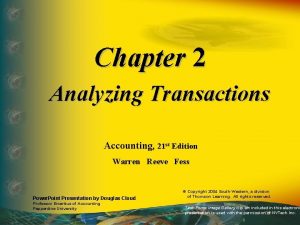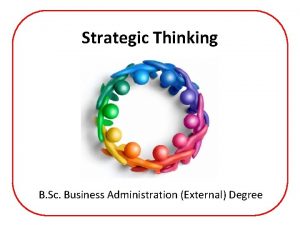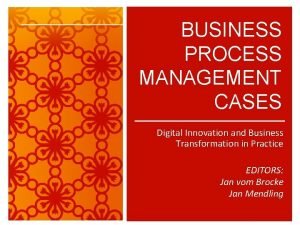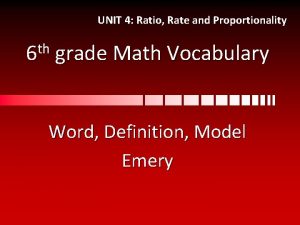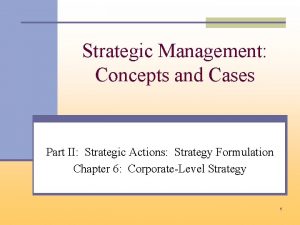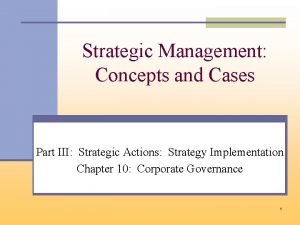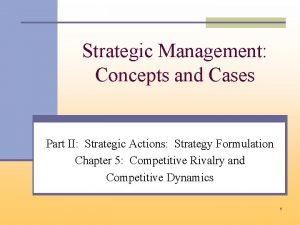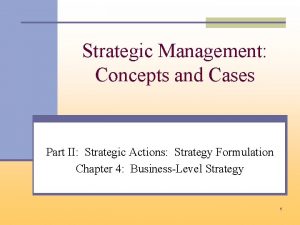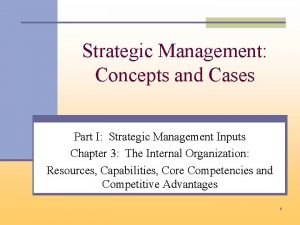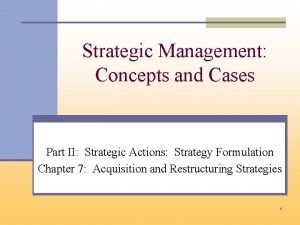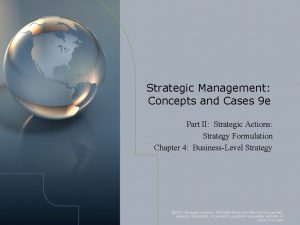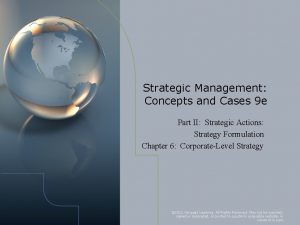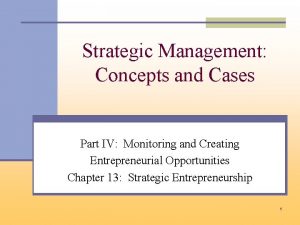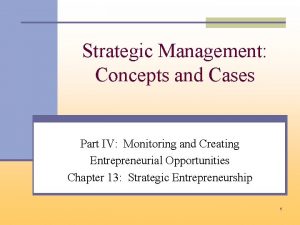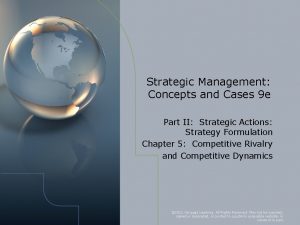Strategic Management Concepts and Cases 9 e Part
























- Slides: 24

Strategic Management: Concepts and Cases 9 e Part II: Strategic Actions: Strategy Formulation Chapter 7: Merger and Acquisition Strategies © 2011 Cengage Learning. All Rights Reserved. May not be scanned, copied or duplicated, or posted to a publicly accessible website, in whole or in part.

The Strategic Management Process © 2011 Cengage Learning. All Rights Reserved. May not be scanned, copied or duplicated, or posted to a publicly accessible website, in whole or in part.

Chapter 7: Acquisition and Restructuring Strategies • Overview: Six content areas – Popularity of acquisition strategies for firms competing in the global economy – Why firms use acquisition strategies – Seven problems working against developing a competitive advantage using an acquisition strategy – Attributes of effective acquisitions – Restructuring strategy vs. common forms – Short & long-term outcomes of different restructuring strategies © 2011 Cengage Learning. All Rights Reserved. May not be scanned, copied or duplicated, or posted to a publicly accessible website, in whole or in part.

Global Merger and Acquisition (M&A) Activity During a Global Crisis • Number of cross-border increased through early 2000 s – Benefits for companies and societies – Activity tends to be cyclical – Heavily influenced by external environment • Tight credit markets • Political changes in foreign countries’ orientation toward M&A • Recent declines – $42 trillion in 2007; $29 trillion in 2008 – First three months of 2009 down 77 percent from same period in 2008 © 2011 Cengage Learning. All Rights Reserved. May not be scanned, copied or duplicated, or posted to a publicly accessible website, in whole or in part.

Chapter 7: Acquisition and Restructuring Strategies • Overview: Six content areas – Popularity of acquisition strategies for firms competing in the global economy – Why firms use acquisition strategies – Seven problems working against developing a competitive advantage using an acquisition strategy – Attributes of effective acquisitions – Restructuring strategy vs common forms – Short & long-term outcomes of different restructuring strategies © 2011 Cengage Learning. All Rights Reserved. May not be scanned, copied or duplicated, or posted to a publicly accessible website, in whole or in part.

Introduction: Popularity of M&A Strategies • Popular strategy among U. S. firms for many years • Can be used because of uncertainty in the competitive landscape – Increase market power because of competitive threat – Spread risk due to uncertain environment – Shift core business into different markets • Due to industry or regularity changes • Intent: increase firm’s strategic competitiveness and value – the reality, however, is returns are close to zero © 2011 Cengage Learning. All Rights Reserved. May not be scanned, copied or duplicated, or posted to a publicly accessible website, in whole or in part.

Introduction: Merger vs. Acquisition vs. Takeover (Cont’d) • Merger – Two firms agree to integrate their operations on a relatively co-equal basis • Acquisition – One firm buys a controlling, 100 percent interest in another firm with the intent of making the acquired firm a subsidiary business within its portfolio. • Takeover – Special type of acquisition strategy wherein the target firm did not solicit the acquiring firm's bid – Hostile Takeover: Unfriendly takeover that is unexpected and undesired by the target firm © 2011 Cengage Learning. All Rights Reserved. May not be scanned, copied or duplicated, or posted to a publicly accessible website, in whole or in part.

Chapter 7: Acquisition and Restructuring Strategies • Overview: Six content areas – Popularity of acquisition strategies for firms competing in the global economy – Why firms use acquisition strategies – Seven problems working against developing a competitive advantage using an acquisition strategy – Attributes of effective acquisitions – Restructuring strategy vs common forms – Short & long-term outcomes of different restructuring strategies © 2011 Cengage Learning. All Rights Reserved. May not be scanned, copied or duplicated, or posted to a publicly accessible website, in whole or in part.

Reasons for Acquisitions • 1. Increased market power – Sources of market power include • Size of the firm, resources and capabilities to compete in the market and share of the market – Horizontal Acquisitions • Acquirer and acquired companies compete in the same industry • i. e. , Mc. Donald’s acquisition of Boston Market – Vertical Acquisitions • Firm acquires a supplier or distributor of one or more of its goods or services; leads to additional controls over parts of the value chain • i. e. , Walt Disney Company’s acquisition of Fox Family Worldwide. – Related Acquisitions • Firm acquires another company in a highly related industry © 2011 Cengage Learning. All Rights Reserved. May not be scanned, copied or duplicated, or posted to a publicly accessible website, in whole or in part.

Reasons for Acquisitions (Cont’d) • 2. Overcoming entry barriers – Cross-border acquisition: headquarters in different country • 3. Cost of new product development and increased speed to market • 4. Lower risk compared to developing new products • 5. Increased diversification • 6. Reshaping firm’s competitive advantage • 7. Learning and developing new capabilities © 2011 Cengage Learning. All Rights Reserved. May not be scanned, copied or duplicated, or posted to a publicly accessible website, in whole or in part.

Reasons for Acquisitions and Problems in Achieving Success © 2011 Cengage Learning. All Rights Reserved. May not be scanned, copied or duplicated, or posted to a publicly accessible website, in whole or in part.

Chapter 7: Acquisition and Restructuring Strategies • Overview: Six content areas – Popularity of acquisition strategies for firms competing in the global economy – Why firms use acquisition strategies – Seven problems working against developing a competitive advantage using an acquisition strategy – Attributes of effective acquisitions – Restructuring strategy vs. common forms – Short & long-term outcomes of different restructuring strategies © 2011 Cengage Learning. All Rights Reserved. May not be scanned, copied or duplicated, or posted to a publicly accessible website, in whole or in part.

Problems in Achieving Acquisition Success • 1. Integration difficulties • 2. Inadequate evaluation of target • 3. Large or extraordinary debt – Junk bonds: financing option whereby risky acquisitions are financed with money (debt) that provides a large potential return to lenders (bondholders) © 2011 Cengage Learning. All Rights Reserved. May not be scanned, copied or duplicated, or posted to a publicly accessible website, in whole or in part.

Problems in Achieving Acquisition Success (Cont’d) • 4. Inability to achieve synergy – Synergy: Value created by units exceeds value of units working independently • Achieved when the two firms' assets are complementary in unique ways • Yields a difficult-to-understand or imitate competitive advantage – Private synergy: Occurs when the combination and integration of acquiring and acquired firms' assets yields capabilities and core competencies that could not be developed by combining and integrating the assets with any other company © 2011 Cengage Learning. All Rights Reserved. May not be scanned, copied or duplicated, or posted to a publicly accessible website, in whole or in part.

Problems in Achieving Acquisition Success (Cont’d) • 5. Too much diversification – Diversified firms must process more information of greater diversity – Scope created by diversification may cause managers to rely too much on financial rather than strategic controls to evaluate performance of business units – Acquisitions may become substitutes for innovation © 2011 Cengage Learning. All Rights Reserved. May not be scanned, copied or duplicated, or posted to a publicly accessible website, in whole or in part.

Problems in Achieving Acquisition Success (Cont’d) • 6. Managers overly focused on acquisitions – Necessary activities with an acquisition strategy • Search for viable acquisition candidates • Complete effective due-diligence processes • Prepare for negotiations – Managing the integration process after the acquisition • Diverts attention from matters necessary for long-term competitive success (I. e. , identifying other activities, interacting with important external stakeholders, or fixing fundamental internal problems) • A short-term perspective and greater risk aversion can result for target firm's managers © 2011 Cengage Learning. All Rights Reserved. May not be scanned, copied or duplicated, or posted to a publicly accessible website, in whole or in part.

Problems in Achieving Acquisition Success (Cont’d) • 7. Too large – Bureaucratic controls • Formalized supervisory and behavioral rules and policies designed to ensure consistency of decisions and actions across different units of a firm – formalized controls decrease flexibility – Additional costs may exceed the benefits of the economies of scale and additional market power – Larger size may lead to more bureaucratic controls – Formalized controls often lead to relatively rigid and standardized managerial behavior – Firm may produce less innovation © 2011 Cengage Learning. All Rights Reserved. May not be scanned, copied or duplicated, or posted to a publicly accessible website, in whole or in part.

Chapter 7: Acquisition and Restructuring Strategies • Overview: Six content areas – Popularity of acquisition strategies for firms competing in the global economy – Why firms use acquisition strategies – Seven problems working against developing a competitive advantage using an acquisition strategy – Attributes of effective acquisitions – Restructuring strategy vs. common forms – Short & long-term outcomes of different restructuring strategies © 2011 Cengage Learning. All Rights Reserved. May not be scanned, copied or duplicated, or posted to a publicly accessible website, in whole or in part.

Effective Acquisitions • Complementary assets or resources • Friendly acquisitions facilitate integration of firms • Effective due-diligence process (assessment of target firm by acquirer, such as books, culture, etc. ) • Financial slack • Low debt position – High debt can… • Increase the likelihood of bankruptcy • Lead to a downgrade in the firm’s credit rating • Preclude needed investment in activities that contribute to the firm’s long-term success • Innovation • Flexibility and adaptability © 2011 Cengage Learning. All Rights Reserved. May not be scanned, copied or duplicated, or posted to a publicly accessible website, in whole or in part.

Chapter 7: Acquisition and Restructuring Strategies • Overview: Six content areas – Popularity of acquisition strategies for firms competing in the global economy – Why firms use acquisition strategies – Seven problems working against developing a competitive advantage using an acquisition strategy – Attributes of effective acquisitions – Restructuring strategy vs. common forms – Short & long-term outcomes of different restructuring strategies © 2011 Cengage Learning. All Rights Reserved. May not be scanned, copied or duplicated, or posted to a publicly accessible website, in whole or in part.

Restructuring • Restructuring defined: Firm changes set of businesses or financial structure • Three restructuring strategies – 1. Downsizing • Reduction in number of firms’ employees (and possibly number of operating units) that may or may not change the composition of businesses in the company's portfolio – 2. Downscoping • Eliminating businesses unrelated to firms’ core businesses through divesture, spin-off, or some other means © 2011 Cengage Learning. All Rights Reserved. May not be scanned, copied or duplicated, or posted to a publicly accessible website, in whole or in part.

Restructuring (Cont’d) • Three restructuring strategies (Cont’d) – 3. Leveraged buyouts (LBOs) – • One party buys all of a firm's assets in order to take the firm private (or no longer trade the firm's shares publicly) • Private equity firm: Firm that facilitates or engages in taking a public firm private • Three types of LBOs – Management buyouts – Employee buyouts – Whole-firm buyouts • Why LBOs? – Protection against a capricious financial market – Allows owners to focus on developing innovations/bring them to market – A form of firm rebirth to facilitate entrepreneurial efforts © 2011 Cengage Learning. All Rights Reserved. May not be scanned, copied or duplicated, or posted to a publicly accessible website, in whole or in part.

Restructuring • Restructuring Outcomes – Short-term • Reduced costs: labor and debt • Emphasis on strategic controls – Long-term • Loss of human capital • Performance: higher/lower • Higher risk © 2011 Cengage Learning. All Rights Reserved. May not be scanned, copied or duplicated, or posted to a publicly accessible website, in whole or in part.

Restructuring and Outcomes © 2011 Cengage Learning. All Rights Reserved. May not be scanned, copied or duplicated, or posted to a publicly accessible website, in whole or in part.
 Criminal cases vs civil cases
Criminal cases vs civil cases Resource based model
Resource based model Cultural aspects of strategy choice
Cultural aspects of strategy choice Benefits of strategic management
Benefits of strategic management Basic concepts of strategic management
Basic concepts of strategic management Basic concept of strategic management
Basic concept of strategic management Basic concept of strategic management
Basic concept of strategic management Basic concept of strategic management
Basic concept of strategic management Public sector strategic management
Public sector strategic management Why is not advisable to pursue too many strategies at once
Why is not advisable to pursue too many strategies at once Strategic management decision making process
Strategic management decision making process Basic concept of strategic management
Basic concept of strategic management Lesson 9: multiplying polynomials
Lesson 9: multiplying polynomials Puppy dog ploy
Puppy dog ploy Part one—analyzing accounting concepts and procedures
Part one—analyzing accounting concepts and procedures Environmental management: readings and cases
Environmental management: readings and cases Strategic family therapy concepts
Strategic family therapy concepts Strategic fit vs strategic intent
Strategic fit vs strategic intent Business process management cases
Business process management cases Puppies, pigs, and people: eating meat and marginal cases
Puppies, pigs, and people: eating meat and marginal cases Part whole model subtraction
Part whole model subtraction Unit ratio definition
Unit ratio definition Brainpop ratios
Brainpop ratios What is technical description
What is technical description Parts of the back bar
Parts of the back bar




